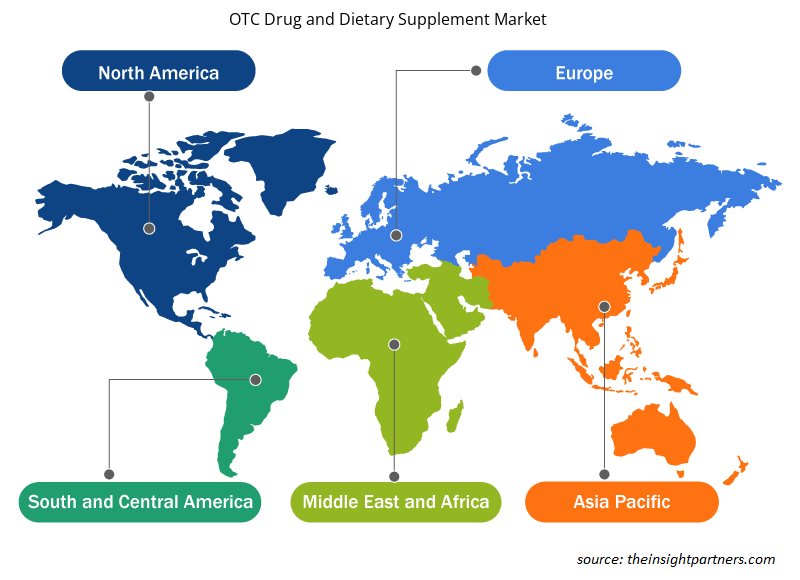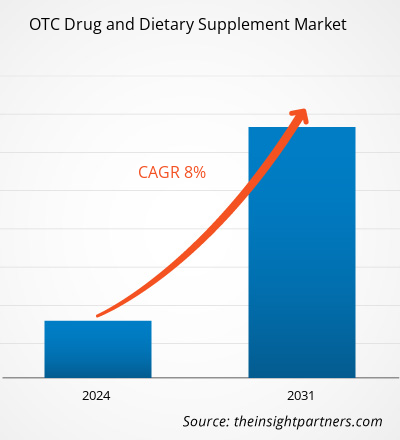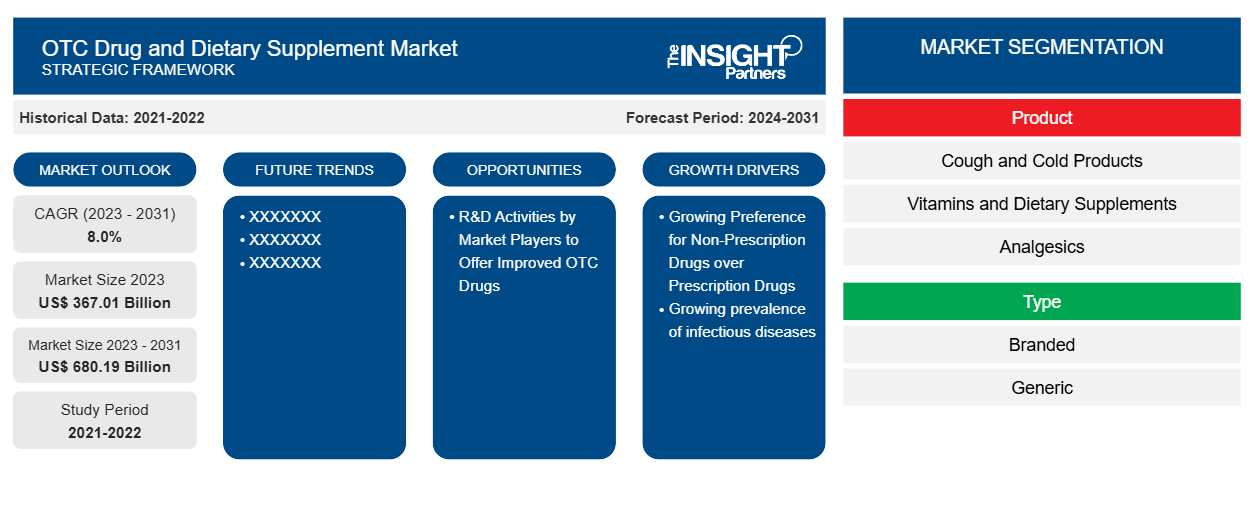Si stima che la dimensione del mercato dei farmaci da banco e degli integratori alimentari sia stata di 367,01 miliardi di dollari nel 2023 e si prevede che raggiungerà i 680,19 miliardi di dollari entro il 2031; si stima che registrerà un CAGR dell'8,0% fino al 2031. La selezione di farmaci da banco per malattie minori rimarrà probabilmente una delle tendenze chiave del mercato dei farmaci da banco e degli integratori alimentari.
Analisi di mercato dei farmaci da banco e degli integratori alimentari
La crescente enfasi sulla cura incentrata sul paziente, i progressi nella tecnologia sanitaria, l'economicità dei farmaci da banco e degli integratori alimentari e la crescente preferenza per la telemedicina stanno principalmente alimentando la crescita del mercato dei farmaci da banco e degli integratori alimentari. Inoltre, l'aumento della popolazione geriatrica, l'aumento dell'assistenza sanitaria domiciliare e l'aumento della prevalenza di malattie croniche e infettive stanno guidando la crescita del mercato dei farmaci da banco e degli integratori alimentari.
Panoramica del mercato dei farmaci da banco e degli integratori alimentari
I farmaci da banco (OTC) sono disponibili al pubblico per il loro scopo generale. I farmaci OTC sono disponibili per vari sintomi medici dovuti a condizioni mediche come tosse e raffreddore, diarrea, bruciore di stomaco, stitichezza, acne, dolore e altri. D'altro canto, gli integratori alimentari sono disponibili OTC per scopi di fitness. Questi farmaci OTC e integratori alimentari hanno due tipi, come di marca o generici.
Personalizza questo report in base alle tue esigenze
Riceverai la personalizzazione gratuita di qualsiasi report, comprese parti di questo report, o analisi a livello nazionale, pacchetto dati Excel, oltre a usufruire di grandi offerte e sconti per start-up e università
-
Scopri le principali tendenze di mercato in questo rapporto.Questo campione GRATUITO includerà analisi di dati che spaziano dalle tendenze di mercato alle stime e alle previsioni.
Driver e opportunità del mercato dei farmaci da banco e degli integratori alimentari
Crescente preferenza per i farmaci da banco rispetto a quelli da prescrizione
La crescente pressione del governo e dei consumatori per ridurre i prezzi aiuterebbe ad accelerare la transizione da prescrizione a OTC (Rx-to-OTC). C'è un ampio sostegno all'uso di OTC tra i medici per febbre, raffreddore/tosse e disturbi minori di quella natura; oltre a ciò, i medici hanno alcune riserve. Sebbene esistano farmaci generici da prescrizione che sono più economici dei farmaci da banco, la maggior parte dei farmaci da banco sono più economici dei farmaci da prescrizione. I farmaci da banco sono preferiti perché sono facilmente reperibili, più accessibili e sono percepiti come più naturali. La crescente preferenza per i farmaci da banco rispetto ai farmaci da prescrizione a causa dei loro vantaggi sta alimentando la crescita del mercato dei farmaci da banco e degli integratori alimentari.
Attività di R&S da parte degli operatori di mercato per offrire farmaci da banco migliorati: un'opportunità per il mercato dei farmaci da banco e degli integratori alimentari
La fiducia dei clienti nei marchi OTC sta incoraggiando i produttori di farmaci a intraprendere un numero sempre maggiore di attività di ricerca e sviluppo per lassativi, antisettici orali, rimedi per il bruciore di stomaco, prodotti antifumo, analgesici e coadiuvanti nutrizionali, tra gli altri composti venduti OTC. Ciò li ha portati ad espandere le loro attività di produzione e R&S. Ad esempio, Novartis Consumer Health Inc. ha aperto il suo terzo centro globale di ricerca e sviluppo per prodotti OTC a Mumbai, in India. In molti paesi sviluppati, la gamma di farmaci OTC disponibili per i consumatori si sta espandendo. Nel frattempo, nei paesi emergenti, l'uso di questi farmaci sta aumentando mentre i sistemi sanitari correlati sono stabili, quindi, si prevede una crescita nei prodotti OTC. I principali attori del mercato applicano strategie come fusioni e acquisizioni per lo sviluppo del mercato dei farmaci OTC e degli integratori alimentari.
Analisi della segmentazione del rapporto di mercato sui farmaci da banco e sugli integratori alimentari
I segmenti chiave che hanno contribuito alla derivazione dell'analisi del mercato dei farmaci da banco e degli integratori alimentari sono prodotto, tipo, forma e canale di distribuzione.
- In base al prodotto, il mercato dei farmaci da banco e degli integratori alimentari è suddiviso in prodotti per tosse e raffreddore, vitamine e integratori alimentari, analgesici, prodotti gastrointestinali, sonniferi, prodotti per l'igiene orale, prodotti oftalmici, antiacidi, prodotti per l'igiene femminile e altri. Il segmento degli analgesici ha detenuto la quota di mercato maggiore nel 2023.
- In base al tipo, il mercato dei farmaci da banco e degli integratori alimentari è diviso in di marca e generico. Il segmento generico ha detenuto la quota di mercato maggiore nel 2023.
- In base alla forma, il mercato è segmentato in compresse, capsule, polveri, unguenti, liquidi e altro. Il segmento delle compresse ha detenuto la quota maggiore del mercato nel 2023.
- In termini di canale di distribuzione, il mercato è segmentato in farmacie ospedaliere e al dettaglio, negozi al dettaglio, canali online e altri. Il segmento delle farmacie ospedaliere e al dettaglio ha detenuto la quota maggiore del mercato nel 2023.
Analisi della quota di mercato dei farmaci da banco e degli integratori alimentari per area geografica
L'ambito geografico del rapporto sul mercato dei farmaci da banco e degli integratori alimentari è suddiviso principalmente in cinque regioni: Nord America, Asia Pacifico, Europa, Medio Oriente e Africa, Sud e Centro America.
Il Nord America ha dominato il mercato dei farmaci da banco e degli integratori alimentari. In Nord America, gli Stati Uniti detengono una quota significativa del mercato dei farmaci da banco e degli integratori alimentari. La crescita in Nord America è caratterizzata da un'elevata prevalenza di malattie infettive, un crescente sostegno governativo all'industria farmaceutica, una crescente spesa sanitaria, una crescente adozione di farmaci da banco, una maggiore adozione di servizi di telemedicina, un aumento del numero di fornitori di servizi e lo sviluppo di istituzioni sanitarie. D'altro canto, la domanda di integratori alimentari è molto più elevata per tutte le fasce d'età negli Stati Uniti.telehealth services, increase in number of service providers, and developing healthcare institutions. On the other hand, the dietary
Approfondimenti regionali sul mercato dei farmaci da banco e degli integratori alimentari
Le tendenze regionali e i fattori che influenzano il mercato dei farmaci da banco e degli integratori alimentari durante il periodo di previsione sono stati ampiamente spiegati dagli analisti di Insight Partners. Questa sezione discute anche i segmenti e la geografia del mercato dei farmaci da banco e degli integratori alimentari in Nord America, Europa, Asia Pacifico, Medio Oriente e Africa e America centrale e meridionale.

- Ottieni i dati specifici regionali per il mercato dei farmaci da banco e degli integratori alimentari
Ambito del rapporto sul mercato dei farmaci da banco e degli integratori alimentari
| Attributo del report | Dettagli |
|---|---|
| Dimensioni del mercato nel 2023 | 367,01 miliardi di dollari USA |
| Dimensioni del mercato entro il 2031 | 680,19 miliardi di dollari USA |
| CAGR globale (2023-2031) | 8,0% |
| Dati storici | 2021-2022 |
| Periodo di previsione | 2024-2031 |
| Segmenti coperti |
Per Prodotto
|
| Regioni e Paesi coperti |
America del Nord
|
| Leader di mercato e profili aziendali chiave |
|
Densità degli attori del mercato: comprendere il suo impatto sulle dinamiche aziendali
Il mercato dei farmaci da banco e degli integratori alimentari sta crescendo rapidamente, spinto dalla crescente domanda degli utenti finali dovuta a fattori quali l'evoluzione delle preferenze dei consumatori, i progressi tecnologici e una maggiore consapevolezza dei benefici del prodotto. Con l'aumento della domanda, le aziende stanno ampliando la propria offerta, innovando per soddisfare le esigenze dei consumatori e capitalizzando sulle tendenze emergenti, il che alimenta ulteriormente la crescita del mercato.
La densità degli operatori di mercato si riferisce alla distribuzione di aziende o società che operano in un particolare mercato o settore. Indica quanti concorrenti (operatori di mercato) sono presenti in un dato spazio di mercato in relazione alle sue dimensioni o al valore di mercato totale.
Le principali aziende che operano nel mercato dei farmaci da banco e degli integratori alimentari sono:
- Società per azioni GlaxoSmithKline
- Sanofi
- Servizi Johnson e Johnson, Inc.
- Abate
- AbbVie Inc
- Società sanitarie Bausch Inc.
Disclaimer : le aziende elencate sopra non sono classificate secondo un ordine particolare.

- Ottieni una panoramica dei principali attori del mercato dei farmaci da banco e degli integratori alimentari
Notizie e sviluppi recenti sul mercato dei farmaci da banco e degli integratori alimentari
Il mercato dei farmaci da banco e degli integratori alimentari viene valutato raccogliendo dati qualitativi e quantitativi dopo la ricerca primaria e secondaria, che include importanti pubblicazioni aziendali, dati di associazioni e database. Di seguito è riportato un elenco degli sviluppi nel mercato degli antigeni virali e delle strategie:
- Emcure Pharmaceuticals ha annunciato il suo ingresso nel mercato dei farmaci da banco (OTC) con il suo prodotto Galact. Arricchito con la potenza di Shatavari e di altre sei erbe, Galact è meticolosamente formulato per aumentare la produzione di latte materno per le madri. (Fonte: Nuffoods Spectrum, comunicato stampa, 2024)
- McKesson ha lanciato il suo assortimento Foster & Thrive di prodotti per la salute e il benessere da banco (OTC) a marchio privato. Secondo l'azienda, il nuovo marchio unificherà il portafoglio di marchi privati di McKesson che include prodotti OTC venduti con i marchi Health Mart e Sunmark. (Fonte: Bareback Media Pvt. Ltd, comunicato stampa, 2023)
Copertura e risultati del rapporto sul mercato dei farmaci da banco e degli integratori alimentari
Il rapporto "Dimensioni e previsioni del mercato dei farmaci da banco e degli integratori alimentari (2021-2031)" fornisce un'analisi dettagliata del mercato che copre le seguenti aree:
- Dimensioni e previsioni del mercato a livello globale, regionale e nazionale per tutti i segmenti di mercato chiave coperti dall'ambito
- Dinamiche di mercato come fattori trainanti, vincoli e opportunità chiave
- Principali tendenze future
- Analisi dettagliata delle cinque forze PEST/Porter e SWOT
- Analisi di mercato globale e regionale che copre le principali tendenze di mercato, i principali attori, le normative e gli sviluppi recenti del mercato
- Analisi del panorama industriale e della concorrenza che copre la concentrazione del mercato, l'analisi della mappa di calore, i principali attori e gli sviluppi recenti
- Profili aziendali dettagliati
- Analisi storica (2 anni), anno base, previsione (7 anni) con CAGR
- Analisi PEST e SWOT
- Valore/volume delle dimensioni del mercato - Globale, Regionale, Nazionale
- Industria e panorama competitivo
- Set di dati Excel
Report recenti
Rapporti correlati
Testimonianze
Motivo dell'acquisto
- Processo decisionale informato
- Comprensione delle dinamiche di mercato
- Analisi competitiva
- Analisi dei clienti
- Previsioni di mercato
- Mitigazione del rischio
- Pianificazione strategica
- Giustificazione degli investimenti
- Identificazione dei mercati emergenti
- Miglioramento delle strategie di marketing
- Aumento dell'efficienza operativa
- Allineamento alle tendenze normative























 Ottieni un campione gratuito per - Mercato dei farmaci da banco e degli integratori alimentari
Ottieni un campione gratuito per - Mercato dei farmaci da banco e degli integratori alimentari